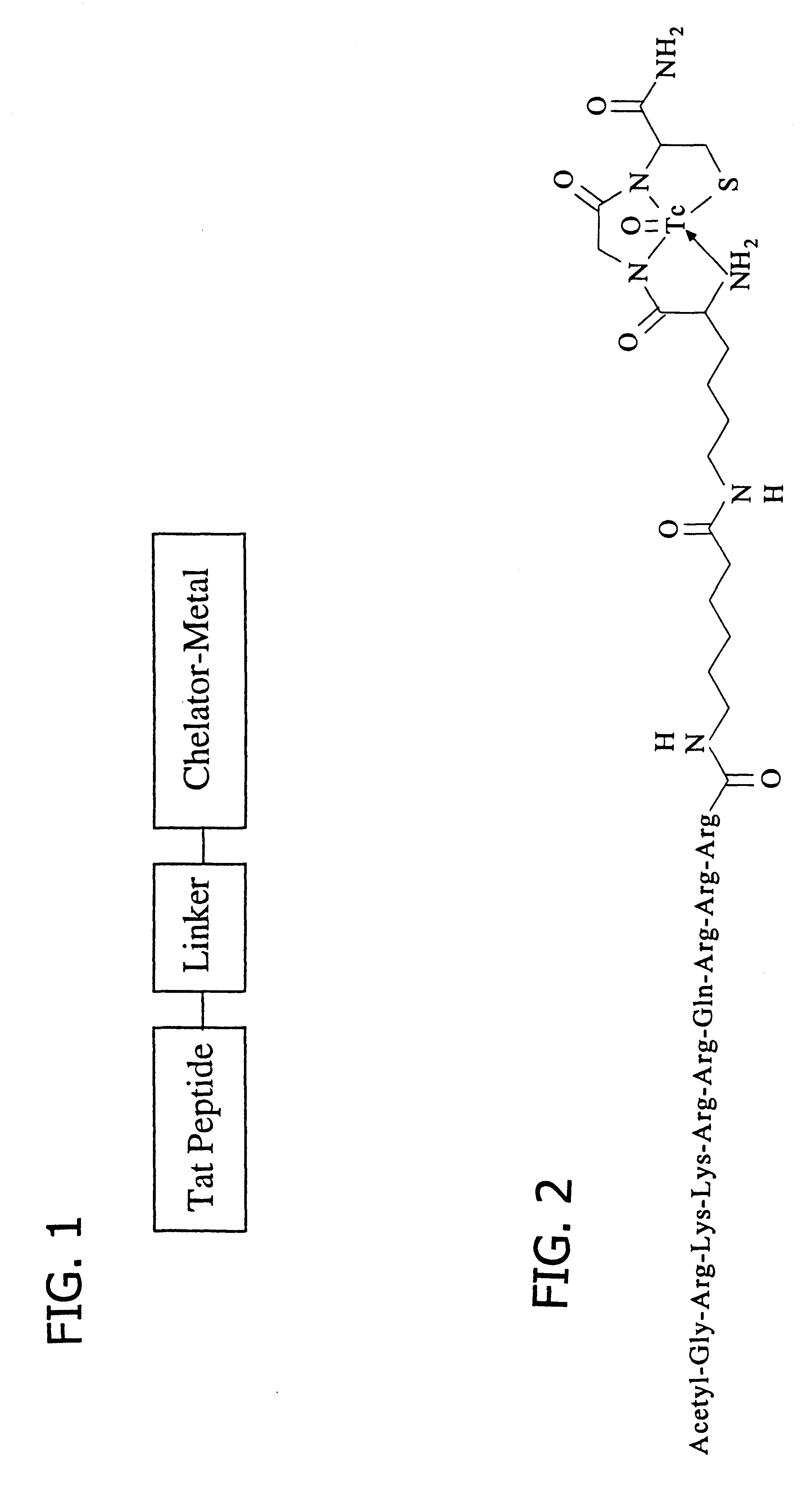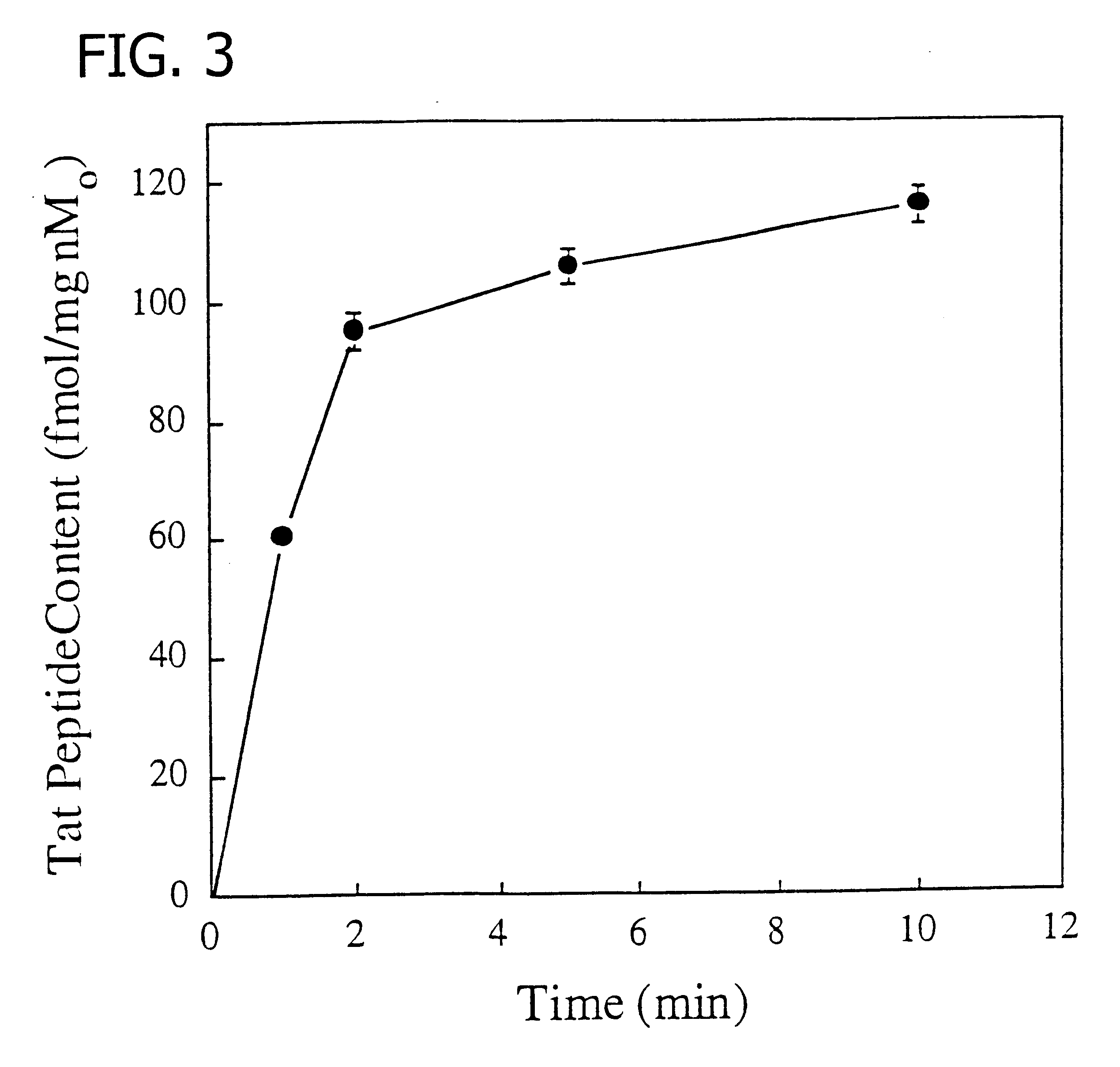Membrane-permeant peptide complexes for medical imaging, diagnostics, and pharmaceutical therapy
a technology of membrane-permeant peptides and complexes, applied in the direction of peptide/protein ingredients, in-vivo radioactive preparations, viruses, etc., can solve the problems of preventing the reporting of peptide metal chelates, preventing the use of peptide radiopharmaceuticals for intracellular targets, and encountered problems
- Summary
- Abstract
- Description
- Claims
- Application Information
AI Technical Summary
Problems solved by technology
Method used
Image
Examples
example 2
Preparation of radiolabeled acetyl-GRKKRRQRRR-AHA-.epsilon.KGC-amide(Tc.sup.v -99m) trifluoroacetate
The Tat peptide conjugate complex of Example 1 was labeled with Tc-99m by ligand exchange using Tc-99m-glucoheptonate as the ligand exchange reagent (Lister-James et al., J Nucl. Med. 38:105-111, 1997). A commercially available stannous glucoheptonate radiopharmaceutical kit (Glucoscan, DuPont Pharma, Billerica, Mass.) was reconstituted with 1.0 ml of (Tc-99m)sodium pertechnetate (50 mCi) in isotonic saline obtained by eluting a commercial radionuclide Mo-99 / Tc-99m generator, and allowed to stand for 15 min at room temperature. In a small glass vial, Tat peptide conjugate (1 mg) was dissolved in 0.9% saline (1 ml). Then, (Tc-99m)glucoheptonate (250 .mu.l) was added and the reaction allowed to proceed at room temperature for 15 min. Radiochemical yield (>95%) of the oxotechnetium complex (FIG. 2) and purity (24 90%) were determined by silica gel TLC using 15% TFA and radiometric detect...
example 3
Preparation of acetyl-GRKKRRORRR-AHA-.epsilon.KGC-amide-fluorescein-maleimide trifluoroacetate
The Tat peptide conjugate of Example 1 was labeled with fluorescein according to Vives et al. (J. Biol. Chem., 272:16010-16017, 1997). In a small glass vial, Tat peptide conjugate (1 mg) was dissolved in phosphate buffered saline (pH 7.4) and reacted with 1.2 eq of fluorescein maleimide dissolved in dimethylformamide for 2 hours in the dark at room temperature. The reaction was monitored by RP-HPLC at both 211 nm and 440 nm. Fluorescent peptides were purified by HPLC (purity >97%) using the above gradient conditions and lyophilized in the dark. The identity of the desired fluorescein labeled peptide was confirmed by electrospray mass spectrometry (m / z: 2211.0).
example 4
Solutions for Cell Uptake Experiments
Control solution for cell uptake experiments was a modified Earle's balanced salt solution (MEBSS) containing (mM): 145 Na.sup.+, 5.4 K.sup.+, 1.2 Ca.sup.2+ 0.8 Mg.sup.2+, 152 Cl.sup.-, 0.8 H.sub.2 PO.sub.4.sup.-, 0.8 SO.sub.4.sup.2-, 5.6 dextrose, 4.0 HEPES, and 1% bovine calf serum (vol / vol), pH 7.4 .+-.0.05. A 130 mM K.sup.+ / 20 mM Cl.sup.- solution was made by equimolar substitution of potassium methanesulfonate for NaCl as described by Piwnica-Worms et al. (J. Gen. Physiol., 81:731-748, 1983).
PUM
| Property | Measurement | Unit |
|---|---|---|
| energy | aaaaa | aaaaa |
| pH | aaaaa | aaaaa |
| temperature | aaaaa | aaaaa |
Abstract
Description
Claims
Application Information
 Login to View More
Login to View More - R&D
- Intellectual Property
- Life Sciences
- Materials
- Tech Scout
- Unparalleled Data Quality
- Higher Quality Content
- 60% Fewer Hallucinations
Browse by: Latest US Patents, China's latest patents, Technical Efficacy Thesaurus, Application Domain, Technology Topic, Popular Technical Reports.
© 2025 PatSnap. All rights reserved.Legal|Privacy policy|Modern Slavery Act Transparency Statement|Sitemap|About US| Contact US: help@patsnap.com



